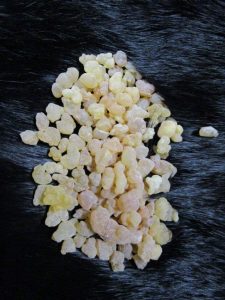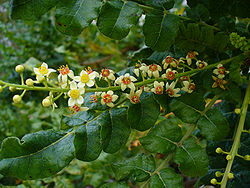Frankincense–A gum resin
Alias names: Boswellia thurifera or Boswellia sacra, Boswellia serrata, dhoop (India) and Olibanum from Arabic term meaning “Oil of Lebanon”. The English word is derived from Old French “franc encens” which means high-quality incense.

Photo of Frankincense tears.
About Frankincense: Frankincense or Olibanum (from the Arabic worl al-lubban meaning ‘white’) is a fragrant gum resin extracted from several species of Boswellia trees, most commonly the Boswellia sacra. It consists of small, white chunks and beads which are easily ground into a powder. It emits a balsam like odor when burned. An important component of religious services, the gum was originally imported from Arabia to Palestine where it was probably produced in the central district of Hadramaut (Isa. 60:6; Jer. 6:20).
The scent is described as being balsamic sweet or spicy, slightly lemon, fragrance of incense with a conifer-like undertone. It was one of the major ingredients of the incense holy unto the Lord (Exod. 30:34-38). The use of this incense for purposes other than those specified in the priestly legislation was forbidden. Stores of frankincense were kept in the Jerusalem temple (1 Chr. 9:29; Neh. 13:5, 9). It was one of the gifts offered to the baby Jesus by the Wise Men (Matt. 2:11). When mixed with other gum resins the end substance is called ‘guggals’.
Frankincense has been traded in Arabia and North Africa for more than 5000 years. It has been described in the Hebrew Bible, the Talmud and in the Old Testament.
Historic Uses & Current Research for Frankincense:
Frankincense gum resin, a bitter, pungent, warming herb is used by burning the gum as in incense, grinding it into powder, or making it into an essential oil.
- Air purifier
- Aging (Antiwrinkle creams)
- Antidepressant effects: Reduces serum corticosterone levels and down regulated cortcotrophin releasing factor and up-regulates brain neurotrophic factor components modulating the hypothalamic-pituitary-adrenal axis.
- Anti-inflammatory (much like an NSAID but without the negative side effects)
- Aromatherapy
- Asthma: Essence of the gum is physically and mentally soothing to asthma conditions by helping to calm panic accompanied by shallow breathing.
- Bad breath: Egyptians who lived in Old Testament times chewed frankincense gum for bad breath. The consistency is like gum only stickier.
- Bronchitis/Laryngitis (inhalation of steamed form)
- Bursitis
- Cancer: One study showed that it killed late stage ovarian cancer cells that had become resistant to chemotherapy. It is being studied for breast, bladder, colon, prostate and other forms of cancer as well.
- Ceremony: Historically in Jewish ceremony, frankincense was used as one of the four ‘sweet scents’ pounded together in equal proportion (balsam, myrrh and benzoin were the other three and some sources mention cloves)
- Depilatory: Melted, it was used as a depilatory (hair removal—can you imagine?)
- Dysentery
- Eye shadow: Charred frankincense is the base for Egyptian eyelid makeup.
- Fevers
- Fumigant: Its smoke was used as a fumigant to cleanse sickrooms and drive out evil spirits and to ward off infection.
- Gene expression affects: It may act on the brain to suppress depressive-like disorders.
- Gum Disease (Mouth rinse)
- Hemlock poisoning antidote
- Incense: Roman Catholic churches use it as incense (sometimes mixed with Benzoin or Storax).
- Leprosy (in China)
- Memory and Longevity
- Menstrual pain (Chinese medicine)
- Nervous Energy: Rub frankincense essential oil on the bottom of your feet to help alleviate nervous energy.
- Perfume: Mixed with other ingredients it was used to perfume the hands.
- Pest control: Mixed with a variety of other ingredients and made into an ointment which was used to repel a variety of pests that plagued ancient societies.
- Religious ceremony
- Ringworm
- Rheumatoid arthritis: One study showed significant improvement in as little as seven days (Wikipedia).
- Skin health
- Strengthening the female hormone system
- Ulcers/ulcerative colitis
- Vaginal infections (used as a douche)
- Vomiting and other digestive upset
Harvest and Cultivation of Frankincense:
Boswellia is a leafy deciduous tree. Flowers are white or pale rose. The Boswellia trees on the Somali coast grow without soil out of polished marble rocks, attaching themselves with a bulbous, thick oval mass of substance resembling lime mortar which helps protect it from being ripped off the rocks that it grows on by the harsh weather and violent storms of the area. Boswellia trees growing farther inland do not have this attribute. Differences in variety, soil and climate and the time of harvest increase the diversity of the resin.

The Boswellia flower.
Photo from: Wikipedia https://en.wikipedia.org/wiki/Frankincense
Frankincense trees are scraggly but hardy. They live in well-drained to dry soil in full sun and are propagated by semi-ripe cuttings in the summer months.
Harvest of the pitch/sap begins once the trees have reached 8-10 years of age. Venomous snakes that live in the trees are first frightened away by burning the pitch of the styrax tree (benzoin). The trunk bark is then cut deeply and longitudinally and a narrow strip of bark five inches long is peeled off. The milky sap exudes and hardens upon exposure to the air and the incision is deepened. Three months later (from May through mid-September) the resin, now in tear form, is dried enough to be collected by Somalian people who pay the Arab people for the privilege of collecting it.
The tears are scraped into baskets, the higher quality tears being collected first and the inferior quality tears collected separately. Trees are tapped or striped 2-3x/year. The last tap of the year (in the driest and hottest months) produces the best tears because they are higher in aromatic terpenes, sesquiterpenes and in diperpene content. The more opaque the resin, the better the quality.
The tears are then transported by elephant to the coast where the commodity is then loaded onto ships and transported/used in exchange for other goods.
Current world production of frankincense is about 1000 tons per year. Frankincense quality is determined based on color, purity, aroma, age and shape of the tears. Somalia produces the highest quality resin (Silver and Hojari types) and most of all the harvest goes to the Roman Catholic Church.
Essential oil of frankincense is produced by steam distillation of the tears which eliminates the boswellic acids in the sap. Interestingly, these boswellic acids are used to validate the veracity and purity of frankincense.
It should be noted that frankincense tree populations are declining due to overharvesting and by clearing, burning, grazing and attacks on it by the longhorn beetle. Also, the more the trees are tapped, the less fertile the adult tree becomes in that its seed germinates less frequently than untapped trees.
Chemical Components of Frankincense include:
- Alibanoresin
- Bassorin
- Boswellic acids (triterpenoids)-not in the essential oil
- Diterpenoids
- Essential oils
- Gum Oleoresins
- Incensole acetate (a psychoactive component that relieves depression)
- Ketones
- Monoterpenes
- Monoterpenoles
- Resins
- Sesquiterpenes
- Sesquiterpenols
- Terpenoids
- Volatile oils
- Water soluble gum
Contraindications, safety issues, concerns, harmful drug interactions and allergy precautions for Frankincense: Rare—possible diarrhea, nausea or skin sensitivity—the essential oil should be used diluted and it may cause problems when applied to the face, neck or genital areas. Pregnant women and children should be wary of ingesting. Avoid using on infants and very small children. Long-term effects and side effects of taking frankincense have not yet been scientifically investigated.
Helpful Links and References for Frankincense:
- Frankincense Essential Oil: https://www.youngliving.com/en_US/products/essential-oils/singles/frankincense-essential-oil
- Wikipedia https://en.wikipedia.org/wiki/Frankincense
- About Frankincense: https://www.botanical.com/botanical/mgmh/f/franki31.html